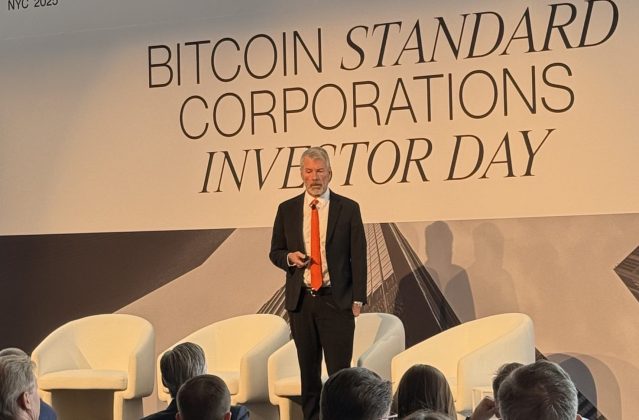Align Commerce recently made headlines at Money 2020 in Las Vegas when their CEO, Marwan Forzley, spoke at one of their panel discussions about cross-border invoicing using the blockchain technology as a transport rail. Cointelegraph sat down with him afterwards to talk more about this new settlement rail and his thoughts on its future in the financial services market.
Cointelegraph: First, for those who don’t know, what is a payment rail?
Marwan Forzley: A payment rail is a payment platform or a payment network that moves money from one entity (a payer) to another (a payee). The payer or the payee could be a consumer or a business, and both parties are moving funds on this network.
“[The blockchain] is also a global infrastructure that is not designed to be local in its construction—there is no distinction between domestic and global payments.”
CT: What are the advantages of utilizing the blockchain, or the technology behind cryptocurrencies such as Bitcoin, as a new settlement rail?
MF: The blockchain is a new payment rail because it has all the characteristics that are important to move money from point A to point B.
It is secure because it is based on cryptographic principles that will increasingly get enhanced with the advancement of multisig-based transactions. It is also a global infrastructure that is not designed to be local in its construction—there is no distinction between domestic and global payments.
Furthermore, it is built in a way where you can attach all kinds of conditions and policies to the network, which is important for operating rails, so that you can easily transport funds around the world. Most of the existing KYC and AML processes can be reapplied on the blockchain.
CT: What is good about having a network of open systems?
MF: With an open network, there [are] going to be a number of markets participating that are working together under a common language. In every country, multiple exchanges convert funds from their local currency to crypto, and these services are important in building a network of global agents that move in and out between both payment types.
This network of agents—with a common protocol and with scale—results in the largest network of payment services worldwide. Because of that, cost structure becomes optimized and the pricing efficiency becomes subjected to the natural supply and demand in the markets where these companies operate. In effect, you end up with a system that is potentially superior to existing private networks.
To put it simply, this new network outsources payment processing to different agents that do different tasks, and they all collaborate using a common global language that makes it possible to send and receive funds efficiently.
“Just like you have millions of apps for the Android and IOS, you can have millions of payment apps that can operate on top of the blockchain.”
CT: Could you tell me more about how the open-system network relates to the development of applications?
MF: Because there is a common language and there is an open environment, the applications that can be built on top of this network are endless. Just like you have millions of apps for the Android and IOS, you can have millions of payment apps that can operate on top of the blockchain. This makes the entire environment suitable for all kinds of applications that cater to financial transactions, in particular cross-border transactions.
CT: How fast is it changing the financial services market?
MF: Bitcoin and the blockchain matter and that is why companies should pay attention to [them]. This is a historic innovation in the financial services market, where just like the Web there will be all kinds of new applications that will be built in order to efficiently move money. This will lead to innovations in the financial services market that will go at a pace that we have never seen before.
“We are also comparing a system that is a couple of years old to networks that have been running for decades. Bitcoin is a young idea and one needs to think of the economics of the network as the system scales.”
CT: Recently, Tim Swanson wrote a response to the viral Western Union ad, and he claimed that Bitcoin remittances are not actually cheaper than Western Union at the moment, and that many other factors must be taken into account, such as converting to local fiat currency. What do you think about his statements?
MF: There are costs to buying bitcoins, selling them, transferring them, running AML / KYC processes, risk management tools, etc. When you pile up all these costs and add the fact that the operator of the service needs to make money in order to sustain operations and scale it, the costs start to pile up.
With that said, we are also comparing a system that is a couple of years old to networks that have been running for decades. Bitcoin is a young idea and one needs to think of the economics of the network as the system scales. As liquidity increases, the costs of running services on the network will decrease and economies of scale will be a big factor.
One last point: There are services in the market that are more expensive than Western Union and they are well used. At the same time, there are services that are cheaper and don’t get as much adoption. Cost is one attribute that influences the way money moves. But there are also other very important attributes: the speed of the payment, value-added functionality, quality of service, reputation, trust, etc. These are all important factors that influence how consumers or businesses make decisions with their money.
CT: What do you see as the key use cases for crypto?
MF: We believe that cryptocurrencies and the blockchain are best suited for cross-border flows, as these types of flows have the highest cost and highest friction. We also believe that there are opportunities for Bitcoin to provide a good environment for large payments outside of the average payments you see on cards, as well as small and micro payments.
We also believe that there will be advanced payment-processing functionality that can be enabled because of Bitcoin multisig capabilities that makes it interesting to handle conditional payments.
CT: By the way, what is Align Commerce and what do you do?
MF: We are a next-generation payment service provider (PSP) for global commerce. We enable businesses and payment platforms to send and receive payments in local currency via a simple, frictionless and inexpensive manner by using the blockchain as a settlement rail. We specialize in two particular use cases: cross-border invoicing and cross-border e-commerce.
Did you enjoy this article? You may also be interested in reading these ones:










